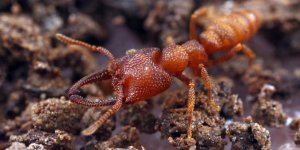| News / Science News |
Venom of Wasp, Bee Repurposed as Antibiotic Drug
The venom of insects such as wasps and bees is full of compounds that can kill bacteria. Unfortunately, many of these compounds are also toxic for humans, making it impossible to use them as antibiotic drugs. Researchers at Massachusetts Institute of Technology have now created variants of the peptide that are potent against bacteria but nontoxic to human cells.

Venom of wasp repurposed as antibiotic drug. ![]()
In a study of mice, the researchers found that their strongest peptide could completely eliminate Pseudomonas aeruginosa, a strain of bacteria that causes respiratory and other infections and is resistant to most antibiotics.
As part of their immune defenses, many organisms, including humans, produce peptides that can kill bacteria. To help fight the emergence of antibiotic-resistant bacteria, many scientists have been trying to adapt these peptides as potential new drugs.
The peptide that researchers focused on in this study was isolated from a wasp known as Polybia paulista. This peptide is small enough—only 12 amino acids—that the researchers believed it would be feasible to create some variants of the peptide and test them to see if they might become more potent against microbes and less harmful to humans.
Like many other antimicrobial peptides, this venom-derived peptide is believed to kill microbes by disrupting bacterial cell membranes. The peptide has an alpha helical structure, which is known to interact strongly with cell membranes.
In the first phase of their study, the researchers created a few dozen variants of the original peptide and then measured how those changes affected the peptides' helical structure and their hydrophobicity, which also helps to determine how well the peptides interact with membranes.
They then tested these peptides against seven strains of bacteria and two of fungus, making it possible to correlate their structure and physicochemical properties with their antimicrobial potency.
Based on the structure-function relationships they identified, the researchers then designed another few dozen peptides for further testing. They were able to identify optimal percentages of hydrophobic amino acids and positively charged amino acids, and they also identified a cluster of amino acids where any changes would impair the overall function of the molecule.
To measure the peptides' toxicity, the researchers exposed them to human embryonic kidney cells grown in a lab dish. They selected the most promising compounds to test in mice infected with Pseudomonas aeruginosa, a common source of respiratory and urinary tract infections, and found that several of the peptides could reduce the infection. One of them, given at a high dose, could eliminate it completely.
The researchers have begun creating additional variants that they hope will be able to clear infections at lower doses. (Tasnim News Agency)
YOU MAY ALSO LIKE




